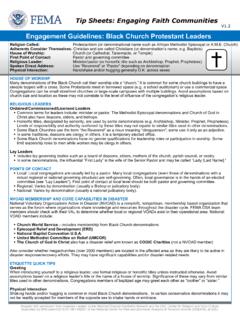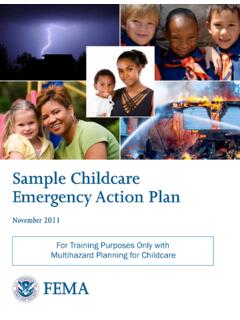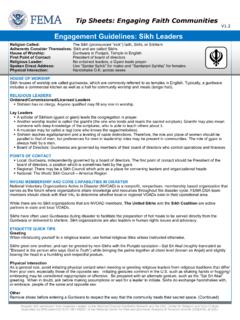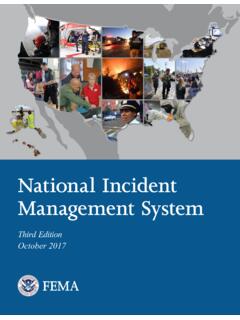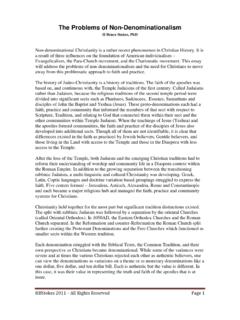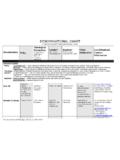Transcription of V1.2 Engagement Guidelines: Latino Protestant …
1 Tip Sheets: Engaging Faith Communities Engagement guidelines : Latino Protestant Leaders Religion Called: Protestantism, evangelical Christianity/evangelicalism, Pentecostalism, or denomination name Adherents Consider Themselves: Cristiano, Protestante and are called Cristianos, evang licos, or Pentecostales House of Worship: Church in English, Iglesia in Spanish First Point of Contact: Pastor and governing committee Religious Leader: Minister/pastor Spoken Direct Address: Use Reverend or Pastor depending on denomination Physical Interaction: Handshakes, hugs, kisses on cheek generally across sexes HOUSE OF WORSHIP. Most Latino Protestant congregations call their place of worship a church. Churches can be small storefront locations or large- scale campuses with multiple buildings. Many houses of worship serve both English-speaking and Spanish-speaking congregations in the same building with separate services for each congregation.
2 Some congregations may worship in members' homes. Many congregations, especially those in urban areas, have had to move locations frequently due to expiration of leases or increasing costs of rent. Some may have limited signage or temporary signs posted only on Sundays. RELIGIOUS LEADERS. Ordained/Commissioned/Licensed Leaders Common terms for Protestant leaders include pastor or reverend. Many Latino Protestant denominations have no gender qualifications for leadership roles or participation in worship. Some limit leadership roles to men while most Pentecostal churches and some other denominations affirm women in leadership. Lay Leaders In many Latino churches the pastor is a layperson. Includes lay governing bodies such as a board of directors, parish council, elders, or vestry. POINTS OF CONTACT. Local: Local congregations are often unaffiliated and led by a part-time pastor.
3 Some may have an elected governing committee. First point of contact at local level should be both pastor and governing committee. Regional: Unaffiliated congregations may be associated with a local network or association (sometimes difficult to identify). National: Varies by denomination (usually a national judicatory body or association La Red). NVOAD MEMBERSHIP AND CORE CAPABILITIES IN DISASTER. National Voluntary Organizations Active in Disaster (NVOAD) is a nonprofit, nonpartisan, membership based organization that serves as the forum where organizations share knowledge and resources throughout the disaster cycle. FEMA DSA team members should check with their VAL to determine whether local or regional VOADs exist in their operational area. While there are no Latino -specific National VOAD members, many Protestant denominations with significant numbers of Latino congregations do have NVOAD affiliates.
4 See the Protestant Leaders Tip Sheet for more information. Also consider whether megachurches (over 2000 members) are located in the affected area as they are likely to have social service programs. Many smaller Latino congregations are also involved in day-to-day social needs of their members such as clothing, food, health care, and housing. ETIQUETTE QUICK TIPS. Greeting When introducing yourself to a religious leader, use formal religious titles unless instructed otherwise. Congregation members of baptized age may greet each other as hermano (brother) or hermana (sister). Physical Interaction Shaking hands, hugging, and kissing on the cheek is common in most Latino Protestant denominations. In certain conservative denominations it may not be readily accepted for members of the opposite sex to shake hands or embrace. Other Some Latino Protestant leaders may not speak English or be more comfortable conversing in Spanish.
5 Dialects vary. When entering a Protestant house of worship, shoes are generally left on but men should remove hats or caps. Other than this practice, traditions around dress codes for both sanctuary spaces and office spaces vary dramatically according to culture and geographical region of the country. In general, there are no rules about what one may wear or not wear, however, Sunday best attire is expected in many churches. Ask before participating in worship services. Guests may be invited to participate in some worship activities. If not a member, limit participation in these activities ( taking communion or healings) unless invited. Ushers can help with customs, dress, and etiquette. Adapted with permission from materials created by the National Disaster Interfaiths Network and the USC Center for Religion and Civic Culture. Supported by DHS award 2010-ST-061-RE001 to the National Center for Risk and Economic Analysis of Terrorism Events (CREATE) at USC.
6 TS Engaging Latino Protestant Religious Leaders ( ). GOVERNANCE / JUDICATORY. Governance structures range from small congregations that are completely self-governing to networks of small churches that affiliate themselves with one of the larger megachurches. The single largest denomination among Latino Protestants is the Assemblies of God. It has 14 Hispanic Districts served by the liaison Office of Hispanic Relations to the national office. Other Latino Pentecostal denominations include: Apostolic Assembly, Concilio Latino Americano de Iglesias Cristianas (CLADIC), El Concilio Latinoamericano Internacional de la Iglesia de Dios Pentecostal de Nueva York (CLANY) and the Asamblea de Iglesias Cristianas. Some Latino churches are linked to denominations from the charismatic renewal movement, Vineyard and Calvary Chapel. Other denominations such as the Adventists, American Baptists, Methodists, Nazarenes, and Southern Baptists have a substantial number of Latino churches.
7 MEETING LOGISTICS AND SCHEDULING. Scheduling and Holidays Sunday is the Sabbath for most Latino Protestants (Saturdays for Seventh Day Adventists). On this day, members of particular Latino communities gather from all parts of a given city. With good relationship building and communication, pastors and their leadership may accommodate hosting a public agency if it is significant to the well-being of the community. Holidays include: Semana Santa (Holy Week): leads up to Easter; begins with Palm Sunday (recalling Jesus' return to Jerusalem); includes Maundy Thursday (recalling Jesus' institution of the practice of Holy Communion during his last meal with his disciples). and Good Friday (recalling Jesus' crucifixion). Pascua (Easter): the most important season in the Christian year celebrating the resurrection of Jesus from the dead. Pentecost s (Pentecost): commemorating the receipt of the Holy Spirit by the nascent Christian community, fifty days after Jesus' Resurrection.
8 This holiday is recognized by many and is a major celebration for some. Navidad (Christmas): a celebration of the birth of Jesus as God incarnate. All Protestants follow the same liturgical calendar, with varying levels of observance for the seasons of Advent and Lent. Some congregations celebrate Homecoming (in late summer, usually). Thanksgiving Day (a national holiday) is celebrated as a religious holiday by some Protestant churches. Food Few general restrictions or requirements; check with individual leaders. Some denominations do take very seriously laws of fasting and abstinence, refraining from eating meat on certain days and limiting the quantity of food on other days. During the season of Lent, some denominations are required to abstain from eating meat on Fridays, but may eat fish. Most Latino evangelicals choose not to drink alcohol. Logistics Be aware that many Latino Protestant leaders are bi-vocational and may have jobs outside of their pastoral duties.
9 Some congregations serve undocumented immigrants or mixed-documentation households. DSA teams should help to explain FEMA's role, limitations of program eligibility and provide referrals to whole community partners as needed. DRESS. Many pastors wear attire similar to that of lay members varies from casual to business casual to Sunday best attire. Religious leaders with a denominational affiliation may wear clothing prescribed by their denomination or a variety of other ecclesiastical clothes based on personal choice or understanding of their denomination's historical preferences. In some Latino Protestant churches, lay females may choose to wear a head covering ( Velo or Mantilla ) as part of a more conservative style of dress. In some churches that use velos, women can take leadership roles if wearing velos. ABOUT Latino Protestant CONGREGATIONS.
10 Note on usage of Latino : The term Latino is used in this Tip Sheet as a term inclusive of both female and male disaster survivors of Latin American origin or ancestry residing in the While this term is used here, it is preferable to refer to each disaster survivor as he/she refers to himself/herself, whether it be through the word Latino /Latina, Hispanic, or a term specific to the survivor's country of origin ( Boriqua - Puerto Rico, Chicano/a - Mexico, Cubano/a - Cuba, Dominicano/a - Dominican Republic, etc.). In the United States, about 68% of Latinos identify as Roman Catholic and 20% identify as Protestant . The percentage of Latinos that are Protestant is growing. Congregants' countries of origin may include those from Central or South America, Mexico, and the Caribbean (Cuba, Dominican Republic, and Puerto Rico). More than half of Latino Protestants (57%) identify as charismatic or Pentecostal.
